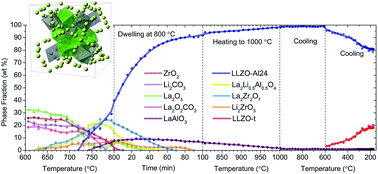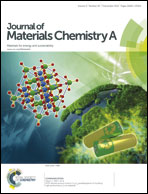A study of suppressed formation of low-conductivity phases in doped Li7La3Zr2O12 garnets by in situ neutron diffraction†
Abstract
Doped Li7La3Zr2O12 garnets, oxide-based solids with good Li+ conductivity and compatibility, show great potential as leading electrolyte material candidates for all-solid-state lithium ion batteries. However, the conductive bulk usually suffers from the presence of secondary phases and the transition towards a low-conductivity tetragonal phase during synthesis. Dopants are designed to stabilize the high-conductive cubic phase and suppress the formation of the low-conductivity phases. In situ neutron diffraction enables a direct observation of the doping effects by monitoring the phase evolutions during garnet synthesis. It reveals the reaction mechanism involving the temporary presence of intermediate phases. The off-stoichiometry due to the liquid Li2CO3 evaporation leads to the residual of the low-conductivity intermediate phase in the as-synthesized bulk. Appropriate doping of an active element may alter the component of the intermediate phases and promote the completion of the reaction. While the dopants aid to stabilize most of the cubic phase, a small amount of tetragonal phase tends to form under a diffusion process. The in situ observations provide the guideline of process optimization to suppress the formation of unwanted low-conductivity phases.


 Please wait while we load your content...
Please wait while we load your content...